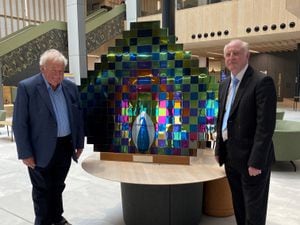"Percy Peacock" takes pride of place at university's school of architecture
A Wolverhampton educated chemistry student who put the colour into stainless steel with an invention that has been reflected in buildings around the world, has donated a prototype "peacock" to the city's university.

Dr Tony Hart, 79, has presented "Percy", designed to show the range and brilliance of colours in the process, to the University of Wolverhampton's School of Architecture and Built Environment at Springfield Campus.
Dr Hart studied A Levels in Chemistry, Physics and Maths at Wolverhampton Technical College before it became Wolverhampton Polytechnic and then the University of Wolverhampton.
He went on to enrol on a Diploma of Technology in Applied Chemistry at Birmingham College of Advanced Technology, working as a trainee chemist at Joseph Lucas Electrical based in Birmingham.
A post as a research investigator in the corrosion section at the International Nickel Research Laboratory saw him develop an innovative technique for colouring the surface of stainless steel using chromium, which, after a six-month trial period working on the hardening effect of treatment, was ready for patenting.
Tony said: “My success with this invention resulted in my being promoted to Leader of the Electroplating Section of the laboratory which actually took me away from the mainstream work of taking a laboratory process into a commercial venture that was adopted worldwide.
"Still, more than 50 years later, it remains in full scale production in many countries and the only process by which stainless steel surfaces can be coloured.”
Percy the Peacock was commissioned for the reception area of the Research Laboratory’s new premises along with a number of other exhibits featuring the success of the laboratory.
Tony said: “Percy remained in the reception area until the laboratory closed in the late 1980s after which it was transferred to the offices of the Nickel Institute in Alvechurch.
"When these offices closed in about 2011 I was presented with the peacock which was on the wall of the reception area of my company Hart Materials Limited in Wombourne.
"I wasn’t sure what to do with Percy and to be serious this is a unique article that demonstrates the visual quality of an electrochemical process that has been used in large scale industrial production for over fifty years and for which these has never been any replacement.
"It is a process developed in a famous West Midlands Laboratory by an industrial chemist who was raised and educated in Wolverhampton so it appeared to me that there was a natural and significant connection with the city which is why I contacted the university.
“The positioning of ‘Percy’ in the School of Architecture and Built environment is most appropriate since the major use of coloured stainless steel is now seen in major architectural projects across the world.”
Paul Hampton, Interim Head of the School of Architecture and Built Environment, said: “We were delighted to accept Percy the peacock for display in our exciting new building.
"The process by which stainless steel is coloured has transformed architecture across the world and this will be of significant interest to students studying in the school – both from an architectural and built environment perspective.
“It’s wonderful to see how the university’s historical presence has resulted in such long-lasting inventions that are still relevant and present in the world today, with very firm roots in Wolverhampton.”





